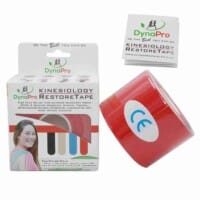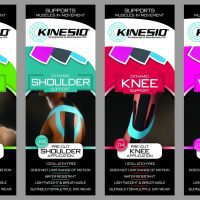-

In Stock
$16.89 – $25.68The Mueller Sports Medicine EASYfit® Kinesiology Tape applications are designed to be simple to use and can help relieve certain overuse injuries. Three (3) applications in each package for the knee, shoulder, foot/arch, calf/ankle/neck and waist/back applications. Six (6) applications in each package for the X & Y pattern applications.
-

In Stock
Rated 5.00 out of 5
$10.26 – $55.17Use DynaPro Kinesiology RestoreTape for possible relief from pain and faster recovery from aching and sore muscles, damaged ligaments, Carpal Tunnel Syndrome, strained muscles /tendons and many other overuse injuries. Available in colours black, blue, beige and red and in lengths of either 5M or 31.5M. Hypoallergenic, latex free and waterproof. May be effective even for periods as long as 4-5 days.
-

$79.58The Mueller Sports Medicine Kinesiology Tape – 30m Continuous Roll features Mueller’s revolutionary wave adhesive pattern for effective rehabilitation of sore, weak or damaged muscles or joints.
-

In Stock
$12.42Mueller Sports Medicine Kinesiology Tape – 5m Continuous Roll is a great choice for rapid rehabilitation for your sore, weak or injured muscles and joints. With its revolutionary wave pattern adhesive, it will lift your skin as you move to optimize your circulation and promote early recovery to full health. You cn wear it for up to 5 days at a time. Made from pure high grade cotton. Latex free, highly elastic and breathable in order to perform its “lifting” function more effectively.
-

$16.89The Mueller Sports Medicine Kinesiology Tape – I-Strip Roll will help you to treat ligament and other soft tissue injuries as well as repetitive stress injuries such as carpal tunnel.
-

NEW
In Stock
$42.39The Kinesio Pre Cut Starter Set includes one each of the Kinesio Pre Cuts for the wrist, knee, back, foot, neck & shoulder.
-

In Stock
$6.64Use Kinesio Pre-Cut Application tapes for treatment of various repetitive stress injuries. As the pieces are pre-cut, you do not need to cut them before putting them on, which simplifies application.
-

In Stock
$11.60 – $17.01Kinesio Tex Classic successfully treats a variety of orthopaedic, neuromuscular, neurological and medical conditions. It provides fast and effective pain relief and support for muscle aches and pains and directly targets the fascia (skin layers) and muscle tissue to treat the cause of muscle inflammation and pain.








